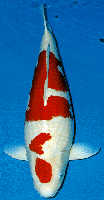Kohaku It has been said that koi keeping begins and ends with the Kohaku. Red patterns set against a white background create an exquisite contrast. Points of appreciation include a bright and evenly colored beni (red), the crispness of the kiwa (the edges of the red patterns), and the snow-like white of the background. The following article was written by Joel Burkard/Pan Intercorp and previously published in PONDSCAPES magazine. All rights reserved Joel Burkard/Pan Intercorp 1995 As with any other koi, the most important point to consider in selecting a Kohaku is the body confirmation. We are often tempted to overlook poor body confirmation when we are enchanted by a koi that has a stunning pattern, but to acquire such a koi invariably turns out to be a mistake as poor body confirmation is usually a result of more serious internal problems that will eventually result in health problems. The beauty of a Kohaku lies in the purity of it's white body and the depth and intensity of the red patterns. The edges of the red markings should be crisp and clear against an unblemished white background. This crisp edge is referred to as the "kiwa". Kohaku come in literally thousands of patterns with no two koi the same but some of the more recognized patterns are as follow:
Kohaku are quite sensitive to water condition. If the water hardness is too high, small black freckles called "shimi" can form on the skin. Softer water will not only prevent shimi from forming but will also encourage the development of the red (beni). The beni in very young koi starts out as a pale yellow that develops into a faint orange, then a deep orange, and then finally, a beautiful red. Males tend to develop their red as early as their first or second year, however they their color tends to peak and diminish not long thereafter. Though females take longer to develop their red, they are likely to have a truly lustrous red that will last for years, making them more popular among the serious hobbyists. It has been said that koi keeping begins and ends with the Kohaku, the beautiful red and white koi that have fascinated koi keepers since the very beginning of the hobby. Kohaku are the undisputed main event of most koi shows and undoubtedly the most sought after of the Living Jewels. BACK TO TOP |
||||||||||||
|
|
||||||||||||


